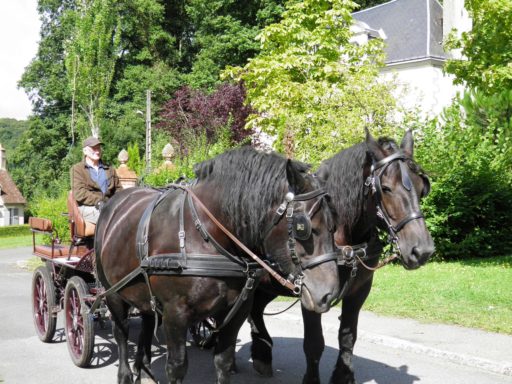Ce week end dans le Perche, j’ai été une nouvelle fois charmée par la Loge du Sabotier, entre Feings et Saint-Mard-de-Réno.
J’aime emprunter le chemin des écoliers pour me rendre à Mortagne-au-Perche. Très honnêtement de la maison, il y a bien plus rapide mais c’est sur la sinueuse départementale 5, au pied du massif forestier de Réno-Valdieu, que se trouve la Loge du Sabotier. Elle a tellement de charme cette petite maison dans la prairie, je l’adore.
A propos du sabotier : avant d’intégrer les bourgades à la fin du XIXe siècle, l’atelier du sabotier était niché à proximité des forêts, au plus près de la matière première. A cette époque, la population rurale portait des sabots, seules les personnes fortunées se chaussant de cuir. Parmi les principales essences de bois utilisées pour la fabrication des sabots se trouvaient le bouleau, le hêtre, le merisier, le noyer et l’orme. Le bois devait être bûché et travaillé vert car il a la propriété de durcir en séchant, se révélant de ce fait très difficile à creuser. La fabrication d’une paire de sabots nécessitait l’emploi d’un grand nombre d’outils et, afin de gagner du temps, les sabotiers fabriquaient de petites séries. Le grenier abritait la production de la journée. Les sabots entreposés y séchaient pendant trois ou quatre mois avant d’être vendus. Le déclin du métier de sabotier s’amorça lors de la Grande Guerre puis s’accéléra dès la fin de la Seconde Guerre Mondiale, les bottes en caoutchouc prenant le relais. Le sabot disparut et il n’y a malheureusement plus, vous vous en doutez, aucun sabotier actif dans le Perche.
Last weekend in the Perche, I was once again charmed by the clog maker workshop “La Loge du Sabotier”, between Feings and Saint-Mard-de-Reno.
I like to take the long way round to get to Mortagne-au-Perche. To be honest, there is much faster from my own house to get there. But, it is on the winding RD5, between Feings and St-Mard-de-Reno, at the foot of Reno Valdieu forest, that you can see the “Loge du Sabotier”. A timeless charm is preserved to this little house on the prairie. I love it.
About clog maker: before joining the villages in the late nineteenth century, the clog maker workshop was located near the forests, closer to the raw material. At this time, the rural population wore clogs, only wealthy people could afford leather shoes. Among the main types of wood used for the manufacture of clogs were the birch, the beech, the cherry wood, the walnut and the elm. The wood should be chopped and worked green because it has the property of hardening in drying, becoming very hard and thus difficult to dig. Making a pair of clogs required the use of a large number of tools and, in order to save time, the clog makers were making small quantities. The daily production was consigned to the attic and, the clogs were drying there for three or four months before being sold. The decline of this old profession begun during the First World War and then accelerated at the end of the Second World War, rubber boots taking over. The clog disappeared and, as you can imagine, there is unfortunately no more active clog maker in Perche.







